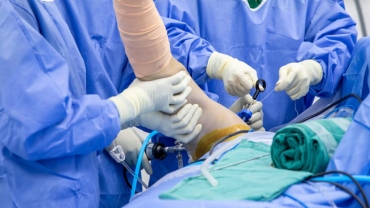Now more than ever, safety in care is a top priority. With the fear surrounding safety during doctor visits, many patients have either needed to postpone surgeries or they have chosen to cancel appointments. Orthopedic patients are amongst those who are looking for safer alternatives during the COVID-19 pandemic. During this time, telemedicine has become a huge value in the orthopedic space.
Telemedicine in the orthopedic space plays an important role because it allows patients to receive care from the safety of their own home. A virtual visit aids in triaging and managing common musculoskeletal conditions. It is also a great option for follow-up visits, reviewing test results and other visits that don’t require an x-ray. Through IBJI’s telemedicine, patients can see their physician, physical therapist, or occupational therapist.
Adapting to telemedicine has helped provide our patients with a safer alternative to the ER and to schedule follow-up visits for their orthopedic condition. We utilize telemedicine to reduce the overall number of in-person visits a patient needs to make over the course of their treatment.
A patient can be “face to face” with a doctor through their phone or camera screen safely at home to discuss their musculoskeletal condition, test results, medication, etc. They don’t have to step out of their comfort by coming into the office and interacting with others.
The huge advantage to telemedicine is that the patients' treatment is not delayed and their multiple follow-up visits can all be scheduled at home. This is important because for some orthopedic conditions, delayed treatment could cause further complications and impact the length of recovery time. Rheumatology and pain management patients also benefit as they often require more frequent visits after diagnosis, many of which can be accomplished virtually.
During a telemedicine visit, a physician will ask you about symptoms, look at your injury from different angles, discuss treatment options, and schedule follow-up visits. IBJI physical and occupational therapists can also be seen through telehealth. This is especially helpful for patients who were in the middle of their recovery process when the stay at home order was put into effect.
Patients can prepare for their visit by reading the instructions that the physicians’ staff provides. Some of this preparation includes, downloading the platform, creating an account, ensuring audiovisual capabilities are functioning, attire, and setting of the visit to decrease the noise and any interruptions.
The presence of telemedicine can greatly impact the future of healthcare as we know it. Telemedicine is beneficial to both the patient and the health care institution. Patients are able to “visit” their doctor in the comfort of their own home, they aren’t putting themselves at risk by leaving the house. Telemedicine is a great option for visits where x-rays or imaging are not needed to determine the diagnosis, for follow-up visits, visits to review test results, medication monitoring, etc. From an institution standpoint, resources such as personal protective equipment can be saved and not depleted.
The way that we use telemedicine will continue to expand. With the rapid incorporation of virtual visits and uncertainty of the future of the pandemic, we can expect to see updates made to telemedicine that improve the technology and user experience. Future modifications could lead to improvements on interactions and examinications.
IBJI was quick to adapt and provide telemedicine as a safer option than the ER. We have had success with telemedicine thus far and expect to continue to see outstanding results with improvements and updates to the technology.




